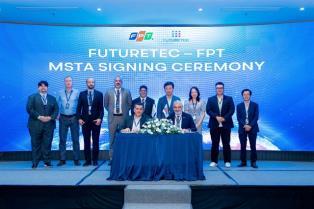The programme, launched during the group’s 50th anniversary celebrations and aligned with recent Government directives on education reform, aims to build 100 international-standard STEM rooms in 34 provinces and cities.

HÀ NỘI — Vietnam National Industry – Energy Group (Petrovietnam) is boosting support for STEM education, partnering with provincial authorities to roll out modern school laboratories nationwide under the 'STEM Innovation Petrovietnam' programme.
The initiative, launched during the group’s 50th anniversary celebrations and aligned with recent Government directives on education reform, aims to build 100 international-standard STEM rooms in 34 provinces and cities.
The rollout comes shortly after the Politburo issued Resolution 71 on accelerating innovation in education and training, signalling stronger national emphasis on developing a skilled workforce.
STEM education combines science, technology, engineering and mathematics in a practical, problem-solving approach that encourages students to apply what they learn through hands-on, project-based activities.
Each classroom is equipped with interactive boards, AI–IoT tools, robotics kits, 3D printers, CNC devices and energy-environment experiment systems, following global reference frameworks such as FabLab, NGSS, ISTE and CSTA.
Local administrators say the facilities allow schools to introduce hands-on activities that were previously difficult to implement due to resource constraints.
At Phan Bội Châu-Nam Dong High School in Lâm Đồng, teachers described the new lab as an opportunity to redesign lessons around experimentation, project-based tasks and problem-solving.
In Hà Nội, Cầu Giấy Secondary School has used its newly installed room to run integrated lessons and robotics competitions. School leaders said the equipment has helped boost student engagement and supported teachers in introducing basic programming and engineering skills.

More remote areas are also seeing benefits.
At Mường Nhé Boarding High School for Ethnic Minorities, administrators said the STEM model helps students learn through experience and real-life applications, making lessons more accessible for first-generation learners. The school has been selected as one of the next sites for Petrovietnam’s deployment.
Education specialists say the programme’s impact depends not only on equipment, but also on training and school-to-school networks.
According to Dr Đặng Văn Sơn of the Vietnam STEM Alliance, the new rooms are “modern enough to raise standards nationwide," but he stressed the need for teacher development, updated evaluation methods and higher awareness among parents to ensure sustainable change in classroom practices.
In Thanh Hóa, where Petrovietnam has installed two labs at Hàm Rồng High School and the Lam Sơn High School for the Gifted, local officials said the initiative offers a template for broader STEM expansion.
“This is not just about new classrooms. It provides a model for how we can scale modern science and technology education across the province,” said Tạ Hồng Lựu, acting director of the Thanh Hóa Department of Education and Training.
Senior Government leaders have also underscored the importance of strengthening STEM programmes as Việt Nam advances its digital transformation and green transition goals.
At a recent inauguration ceremony for two new STEM labs at Tây Mỗ and Tây Mỗ 3 secondary schools in Hà Nội, Deputy Prime Minister Bùi Thanh Sơn stressed technology-focused learning environments are essential for cultivating problem-solving skills, creativity and adaptability among younger generations.
Lawmakers, including members of the National Assembly’s Committee on Economy, said the programme can help provinces improve their long-term workforce planning. They noted that Petrovietnam’s initiative aligns education investment with broader national strategies for industrial upgrading and technological innovation.
The 'STEM Innovation Petrovietnam' programme has been underway for just over two months, with dozens of rooms already inaugurated in Hà Nội, Thanh Hóa, Ninh Bình, Hưng Yên, Tuyên Quang and Cà Mau.
Petrovietnam said it will keep working with education departments to complete the 100 planned STEM rooms and maintain them long term, while linking the facilities with international partners and local universities to support STEM clubs, competitions, career guidance and teacher training.
The group added that the initiative reflects its commitment to supporting workforce development in science and technology, areas considered critical as Việt Nam aims to become a high-income economy by 2045. — VNS





